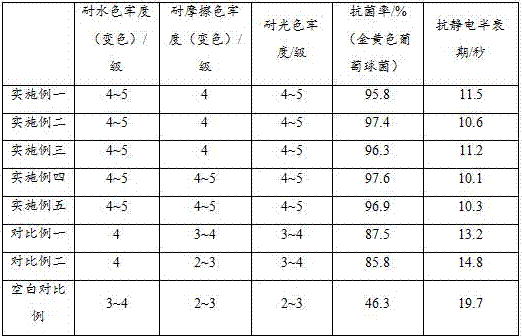Compound textile printing and dyeing auxiliary and preparation technology thereof
A textile printing and dyeing, composite technology, applied in the field of textile printing and dyeing, can solve the problems of unsatisfactory printing and dyeing effect, color fastness and color yield performance, increase printing and dyeing cost and labor intensity, no antibacterial and antistatic functions, etc. Good effect, added antibacterial and antistatic function, excellent color fastness effect
- Summary
- Abstract
- Description
- Claims
- Application Information
AI Technical Summary
Problems solved by technology
Method used
Image
Examples
Embodiment 1
[0026] A composite textile printing and dyeing auxiliary agent, comprising the following raw material components in proportion by weight: 10 parts of α-sulfo-ω-octadecyloxypolyoxyethylene ether, 2 parts of biosurfactant, rare earth oxide 1 part, 3 parts of coconut oil diethanolamide, 4 parts of polyoxyethylene sorbitan monopalmitate, 2 parts of diaminosilicone oil, 2 parts of cocamidopropyl betaine, 1 part of tartaric acid, molecular weight 1200-2000 6 parts of sodium polyacrylate, 5 parts of poloxamer 407, 2 parts of methyl chloroisothiazolinone, 3 parts of sodium tripolyphosphate, 2 parts of isopropyl myristate, 26 parts of ethylene glycol, 18 parts of water ;
[0027] The biosurfactant is a mixture of tea saponin, Sapindus saponin, and sophorolipid, and the mass ratio of the three is 4:2:1;
[0028] The rare earth oxide is a mixture of lanthanum oxide and strontium oxide with a mass ratio of 3:1.
[0029] The preparation process of the above-mentioned composite textile pr...
Embodiment 2
[0034] A composite textile printing and dyeing auxiliary agent, comprising the following raw material components in proportion by weight: 18 parts of α-sulfo-ω-octadecyloxypolyoxyethylene ether, 5 parts of biosurfactant, rare earth oxide 3 parts, 6 parts of coconut oil diethanolamide, 8 parts of polyoxyethylene sorbitan monopalmitate, 6 parts of diaminosilicone oil, 5 parts of cocamidopropyl betaine, 4 parts of tartaric acid, molecular weight 1200-2000 11 parts of sodium polyacrylate, 10 parts of poloxamer 407, 7 parts of methyl chloroisothiazolinone, 5 parts of sodium tripolyphosphate, 6 parts of isopropyl myristate, 38 parts of ethylene glycol, and 30 parts of water ;
[0035] The biosurfactant is a mixture of Sapindus saponins, sophorolipids, trehalolipids and cysteine, and the mass ratio of the four is 2:1.2:3.5:1;
[0036] The rare earth oxide is a mixture of strontium oxide, cobalt oxide and cerium oxide in a mass ratio of 4:1:2.
[0037] The preparation process of the...
Embodiment 3
[0042] A composite textile printing and dyeing auxiliary agent, comprising the following raw material components in proportion by weight: 14 parts of α-sulfo-ω-octadecyloxypolyoxyethylene ether, 3 parts of biosurfactant, rare earth oxide 2 parts, 4.5 parts of coconut oil diethanolamide, 6 parts of polyoxyethylene sorbitan monopalmitate, 4 parts of diamino silicone oil, 3.5 parts of cocamidopropyl betaine, 2.5 parts of tartaric acid, molecular weight 1200-2000 8 parts of sodium polyacrylate, 7 parts of poloxamer 407, 4.5 parts of methyl chloroisothiazolinone, 4 parts of sodium tripolyphosphate, 4 parts of isopropyl myristate, 32 parts of ethylene glycol, 24 parts of water ;
[0043] The biosurfactant is a mixture of tea saponin, sophorolipid and trehalolipid, and the mass ratio of the three is 2:1:5;
[0044] The rare earth oxide is a mixture of lanthanum oxide, cobalt oxide and cerium oxide in a mass ratio of 4:1:3.
[0045] The preparation process of the above-mentioned com...
PUM
 Login to View More
Login to View More Abstract
Description
Claims
Application Information
 Login to View More
Login to View More - R&D
- Intellectual Property
- Life Sciences
- Materials
- Tech Scout
- Unparalleled Data Quality
- Higher Quality Content
- 60% Fewer Hallucinations
Browse by: Latest US Patents, China's latest patents, Technical Efficacy Thesaurus, Application Domain, Technology Topic, Popular Technical Reports.
© 2025 PatSnap. All rights reserved.Legal|Privacy policy|Modern Slavery Act Transparency Statement|Sitemap|About US| Contact US: help@patsnap.com

